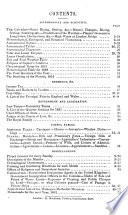 | William Nicholson - Natural history - 1809 - 716 pages
...the numbers by which they are expressed, he found that the squares of the times of the revolutions of the planets are to each other as the cubes of their mean distances from the sun ; and that the same law applies equally to their satellites. See KBPLER. At the same time also that... | |
 | Edward Polehampton - 1815 - 592 pages
...Kepler discovered his third fundamental law; namely, III. The squares of the times of the revolutions of the planets are to each other as the cubes of their mean distances. The ellipses, which the planets describe, however, are not unalterable. Their major axes appear to... | |
 | 1824 - 604 pages
...bodies in the solar system, and probably every other body in the whole compass of space. This law, viz. that the squares of the periodic times of the planets...other as the cubes of their mean distances from the central body, was first discovered by Kepler, and afterwards demonstrated by Sir Isaac Newton. Thus,... | |
 | William Nicholson - Natural history - 1819 - 370 pages
...the numbers by which they are expressed, he found that the squares of the times of the revolutions of the planets are to each other as the cubes of their mean distances from the sun; and that the same law applies equally to their satellites. See KEFLF.R. At the same time also that... | |
 | Alexander Jamieson - Natural history - 1821 - 448 pages
...Kepler discovered his third fundamental law; namely, 252. The squares of the times of the revolutions of the planets are to each other as the cubes of their mean distances. Obs. The ellipses, which the planets describe, however, are not unalterable. Their major axes appear... | |
 | 1843 - 684 pages
...proportional to the times employed in describing them. 3d. The squares of the times of the sidereal revolution of the planets are to each other as the cubes of their mean distances. Kepler's rapture on this discovery was unbounded. " It is now," says he, " eighteen months since I... | |
 | George G. Carey - Astronomy - 1825 - 274 pages
...time. 2. That each of the primary planets describes an ellipse, having the sun in one of its foci.* 3. That the squares of the periodic times of the planets...as the cubes of their mean distances from the sun. These three laws are the basis of all physical astronomy. But in a popular work like the present, it... | |
 | William Rogerson - 1828 - 482 pages
...the times employed in describing them : third, the squares of the times of the sidereal revolutions of the planets are to each other as the cubes of their mean distance. — S, 1702, William III. died.— 16, 1792, King of Sweden murdered.— 20, 1727, Sir Isaac... | |
 | Adam Clarke - God - 1831 - 334 pages
...bodies in the solar system, and probably every other body in the whole compass of space. This law, viz. that the squares of the periodic times of the planets...other as the cubes of their mean distances from the central body, was first discovered by Kepler, and afterwards demonstrated by Sir Isaac Newton, as the... | |
 | Commerce - 1840 - 556 pages
...which a body revolves around the sun, we can find the longer axis of its orbit by Kepler's law — that the squares of the periodic times of the planets are to one another as the cubes of the major ones of their orbits. This law is known to govern all the bodies... | |
| |